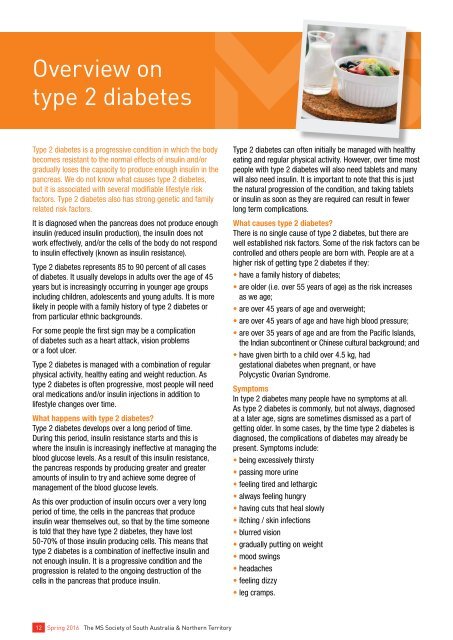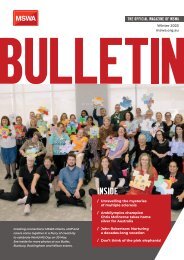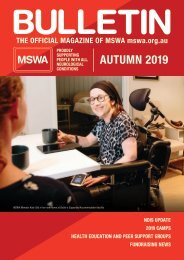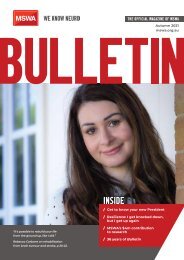You also want an ePaper? Increase the reach of your titles
YUMPU automatically turns print PDFs into web optimized ePapers that Google loves.
Overview on<br />
type 2 diabetes<br />
Limit foods high in energy such as takeaway foods, sweet<br />
biscuits, cakes, sugar sweetened drinks and fruit juice,<br />
lollies, chocolate and savoury snacks. Some people have a<br />
healthy diet but eat too much. Reducing your portion size is<br />
one way to decrease the amount of energy you eat. Being<br />
active has many benefits. Along with healthy eating, regular<br />
physical activity can help you to manage your blood glucose<br />
levels, reduce your blood fats (cholesterol and triglycerides)<br />
and maintain a healthy weight.<br />
Exercise<br />
Everybody benefits from regular exercise. For people<br />
who have diabetes, or are at risk of diabetes, it plays an<br />
important role in keeping them healthy.<br />
For a person with diabetes, exercise helps:<br />
• insulin to work better, which will improve your diabetes<br />
management;<br />
• maintain a healthy weight;<br />
• lower your blood pressure;<br />
• reduce your risk of heart disease; and<br />
• reduce stress.<br />
Type 2 diabetes is a progressive condition in which the body<br />
becomes resistant to the normal effects of insulin and/or<br />
gradually loses the capacity to produce enough insulin in the<br />
pancreas. We do not know what causes type 2 diabetes,<br />
but it is associated with several modifiable lifestyle risk<br />
factors. Type 2 diabetes also has strong genetic and family<br />
related risk factors.<br />
It is diagnosed when the pancreas does not produce enough<br />
insulin (reduced insulin production), the insulin does not<br />
work effectively, and/or the cells of the body do not respond<br />
to insulin effectively (known as insulin resistance).<br />
Type 2 diabetes represents 85 to 90 percent of all cases<br />
of diabetes. It usually develops in adults over the age of 45<br />
years but is increasingly occurring in younger age groups<br />
including children, adolescents and young adults. It is more<br />
likely in people with a family history of type 2 diabetes or<br />
from particular ethnic backgrounds.<br />
For some people the first sign may be a complication<br />
of diabetes such as a heart attack, vision problems<br />
or a foot ulcer.<br />
Type 2 diabetes is managed with a combination of regular<br />
physical activity, healthy eating and weight reduction. As<br />
type 2 diabetes is often progressive, most people will need<br />
oral medications and/or insulin injections in addition to<br />
lifestyle changes over time.<br />
What happens with type 2 diabetes?<br />
Type 2 diabetes develops over a long period of time.<br />
During this period, insulin resistance starts and this is<br />
where the insulin is increasingly ineffective at managing the<br />
blood glucose levels. As a result of this insulin resistance,<br />
the pancreas responds by producing greater and greater<br />
amounts of insulin to try and achieve some degree of<br />
management of the blood glucose levels.<br />
As this over production of insulin occurs over a very long<br />
period of time, the cells in the pancreas that produce<br />
insulin wear themselves out, so that by the time someone<br />
is told that they have type 2 diabetes, they have lost<br />
50-70% of those insulin producing cells. This means that<br />
type 2 diabetes is a combination of ineffective insulin and<br />
not enough insulin. It is a progressive condition and the<br />
progression is related to the ongoing destruction of the<br />
cells in the pancreas that produce insulin.<br />
Type 2 diabetes can often initially be managed with healthy<br />
eating and regular physical activity. However, over time most<br />
people with type 2 diabetes will also need tablets and many<br />
will also need insulin. It is important to note that this is just<br />
the natural progression of the condition, and taking tablets<br />
or insulin as soon as they are required can result in fewer<br />
long term complications.<br />
What causes type 2 diabetes?<br />
There is no single cause of type 2 diabetes, but there are<br />
well established risk factors. Some of the risk factors can be<br />
controlled and others people are born with. People are at a<br />
higher risk of getting type 2 diabetes if they:<br />
• have a family history of diabetes;<br />
• are older (i.e. over 55 years of age) as the risk increases<br />
as we age;<br />
• are over 45 years of age and overweight;<br />
• are over 45 years of age and have high blood pressure;<br />
• are over 35 years of age and are from the Pacific Islands,<br />
the Indian subcontinent or Chinese cultural background; and<br />
• have given birth to a child over 4.5 kg, had<br />
gestational diabetes when pregnant, or have<br />
Polycystic Ovarian Syndrome.<br />
Symptoms<br />
In type 2 diabetes many people have no symptoms at all.<br />
As type 2 diabetes is commonly, but not always, diagnosed<br />
at a later age, signs are sometimes dismissed as a part of<br />
getting older. In some cases, by the time type 2 diabetes is<br />
diagnosed, the complications of diabetes may already be<br />
present. Symptoms include:<br />
• being excessively thirsty<br />
• passing more urine<br />
• feeling tired and lethargic<br />
• always feeling hungry<br />
• having cuts that heal slowly<br />
• itching / skin infections<br />
• blurred vision<br />
• gradually putting on weight<br />
• mood swings<br />
• headaches<br />
• feeling dizzy<br />
• leg cramps.<br />
Eating Well<br />
Healthy eating and an active lifestyle are important for<br />
everyone, including people with diabetes. Having a healthy<br />
diet and being active is an important part of managing<br />
diabetes because it will help manage the blood glucose<br />
levels and body weight.<br />
Meals that are recommended for people with diabetes are<br />
the same as for those without diabetes; there is no need to<br />
prepare separate meals or buy special foods.<br />
Everyone including family and friends can enjoy the<br />
same healthy and tasty meals together. As a guide, it is<br />
recommended people with diabetes follow the Australian<br />
Dietary Guidelines - Healthy Eating for Adults and Children.<br />
What should be eating?<br />
Eating the recommended amount of food from the five food<br />
groups will provide you with the nutrients you need to be<br />
healthy and prevent chronic diseases such as obesity and<br />
heart disease.<br />
To help manage your diabetes:<br />
• Eat regular meals and spread them evenly throughout<br />
the day<br />
• Eat a diet lower in fat, particularly saturated fat<br />
• If you take insulin or diabetes tablets, you may need<br />
to have between meal snacks<br />
• It is important to recognise that everyone’s needs are<br />
different. For individualised advice, all people with<br />
diabetes should see an Accredited Practicing Dietitian<br />
in conjunction with their diabetes team.<br />
Energy balance<br />
Matching the amount of food you eat with the amount of<br />
energy you burn through activity and exercise is important.<br />
Putting too much fuel in your body can lead to weight gain.<br />
Being overweight or obese can make it difficult to manage<br />
your diabetes and can increase the risk of heart disease,<br />
stroke and cancer.<br />
Taking care of the feet<br />
Ulcers or other lesions on the feet are a serious danger for<br />
people with diabetes. It is important to avoid foot damage<br />
especially for middle-aged and elderly people.<br />
It is important to:<br />
• always inspect your feet before and after exercise<br />
• avoid exercise that causes stress to the feet (e.g. running)<br />
Exercise which poses minimal weight or stress on the feet<br />
is ideal i.e. riding an exercise bike or brisk walking in good<br />
footwear. Wear comfortable and well-fitting shoes. See a<br />
podiatrist for foot care and advice.<br />
Maintaining a healthy weight<br />
One of the most important aspects of diabetes management<br />
is to maintain a healthy body weight. Being overweight not<br />
only increases the risk of heart disease, stroke and some<br />
cancers, it also makes diabetes harder to manage. Small<br />
changes in diet such as reducing portion sizes and swapping<br />
to low fat dairy products, can help to achieve a healthy body<br />
weight and manage diabetes.<br />
A small weight loss (5-10% of body weight) can make a big<br />
difference to diabetes management and, as a consequence,<br />
reduce the risk of developing complications like heart<br />
disease, stroke and some cancers. If there is a risk of<br />
pre-diabetes (impaired fasting glucose or impaired<br />
glucose tolerance), losing 5-10% of a person’s current body<br />
weight can prevent type 2 diabetes in up to nearly 6 out of<br />
10 people.<br />
Article Credits:<br />
Diabetes Australia<br />
Dee Lucey, Community Access Nurse<br />
12 <strong>Spring</strong> 20<strong>16</strong> The MS Society of South Australia & Northern Territory The MS Society of South Australia & Northern Territory <strong>Spring</strong> 20<strong>16</strong> 13


















